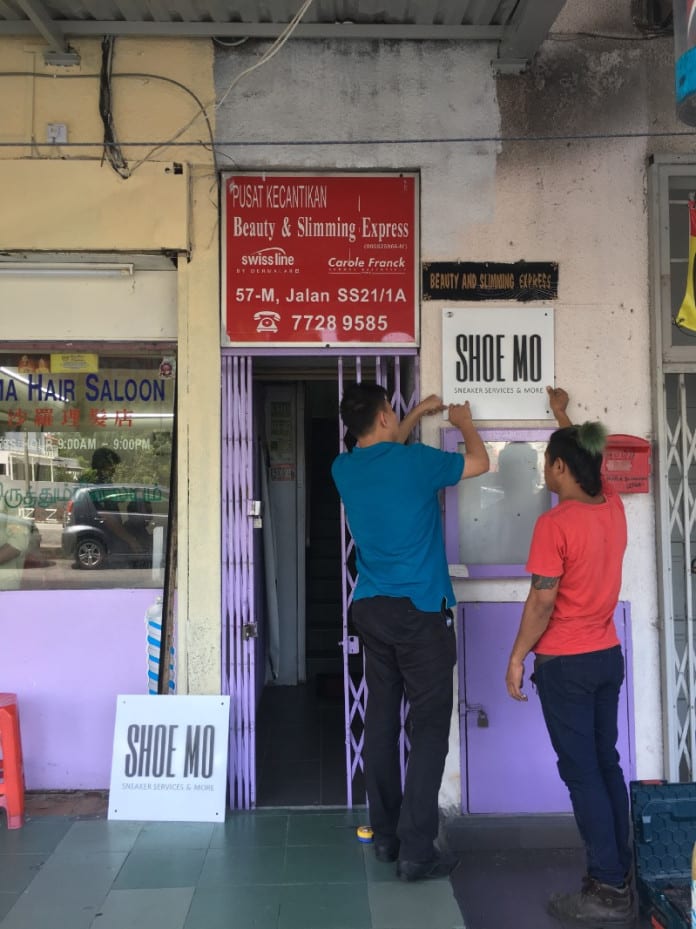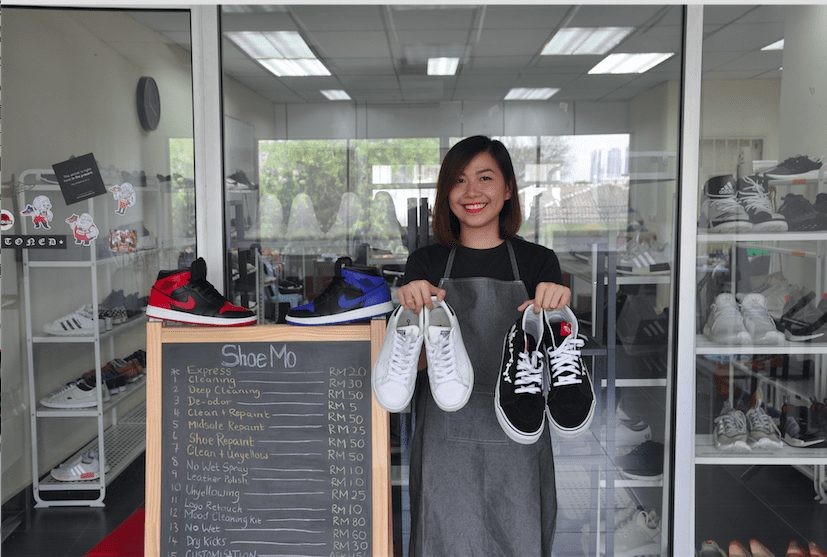Merchant Stories: Real stories from real people – successes and struggles from the small business owner. We’ll let the story do the telling.
Here’s Ginny from Shoe Mo, and how she launched her sneaker laundry empire.
Always On the Move
Ginny was always on the move, never standing still. After graduating, she had 4 jobs in 5 years, developing her skills in working with customers, marketing and analytics. Her successes landed her a job in Grab Vietnam. Many people would have been satisfied, but Ginny took a risk and left for another role with a company abroad, in Malaysia, with even more responsibilities.
Things looked great. Ginny was a go-getter with a career in tech. She was on an upward trajectory, moving from success to success. But there was something missing; she wanted more control over her own fate.
“What do I do next?”
Ginny had a fear of getting stuck in the same role, doing the same thing day after day “What do I do next?” was the question that spurred her to keep moving, keep pursuing new opportunities and seeking out new experiments. What she was really looking for was a place where her decisions had bigger impact and change the direction of the business.
It wasn’t the same as being in charge — she had managed teams before. It was a sense of being able to chart her own course and be captain of her fate. She wanted to prove to herself that she could create real change and see its effects.
Starting Something Different – Shoe Mo
The idea for Shoe Mo came out of nowhere – but it was because Ginny’s shoes needed cleaning. One evening, after a run with her friend Jack, she asked about the local sneaker laundry. Jack listened carefully as Ginny analysed the the business model.
In Vietnam, where Ginny was from, it was quite common to send shoes and sneakers for cleaning. Ginny herself loved the way her shoes came back clean and fresh, just like new, and had even sent all her shoes for cleaning before moving to Malaysia. That day, right after the run, she was just thinking her shoes could use some cleaning.
Jack was good at spotting opportunities, and this seemed like an opportunity. He had all kinds of sales and marketing stints under his belt, and was daring; he had once driven halfway around the world in an old jeep with some friends. There was no such business in Malaysia yet – but Ginny and him could start it. Before they knew it, they were planning to dip their toe in to test the market.
Testing the Market
They got their first ‘customers’ by asking friends and family – and soon they had lots of orders. They offered an incredible rate of RM10 (US$2.40) for cleaning including pick-up and drop off, and soon realised they needed to raise prices to something more reasonable. They didn’t know how to do professional sneaker cleaning, so they watched YouTube videos and experimented themselves.
Every evening, after a day’s work at their full-time jobs, Jack & Ginny would set about clearing orders and handling their business. Jack would drive to do pick-ups, Ginny would do marketing, and then they would both sit down to clean shoes. This was stressful and tiring as they sacrificed their rest, personal time and social lives on weekends and in the evenings. And, Jack’s house would always smell like shoes after pick-up. Still, their fatigue meant there was a market demand, that people would pay for such a service.

Shoe Mo’s humble beginnings in Jack’s home. Via Ginny’s blog
Ginny says all she needed to do was to post on various platforms like Facebook and Carousell, but that was enough. Soon, word-of-mouth spread and people were messaging them to ask for shoe cleaning. The day their first Google Ad went out, their Facebook pageviews jumped 1000% and they knew they had a business on their hands.
While still working their day jobs, they tweaked their prices, let customers handle pick-up and drop-off themselves, and hired and opened their first outlet with a full-timer, and Shoe Mo was officially in business.

Shoe Mo’s first outlet – built with hard work and DIY . Credit: Ginny
Needing a Better Way to Manage People
As a service business, Ginny knew they needed scale to generate profit. That meant more orders, and more outlets. Seeing good demand, Ginny quit her job and they opened a second outlet. With Jack still focused on his full-time job, two locations meant Ginny splitting time between them, and that was when the scaling problems began.
Staffing Problems at the Start
Some early employees showed initiative, learned quickly, and grew with the company. But at the start, there were also some problems caused by staff. Cash would go missing from outlets. Orders would be taken without a receipt. A rival sneaker laundry competitor was also started by ex-staff.
Ginny knew then that managing staff well and building good operational procedures would be important for growing the business.
More Customers meant More Questions
As the business grew, so did the customer base, which also became a source of stress. With only a few customers, Ginny could simply reply to customers herself, but soon the number of customers texting about their orders and new leads asking questions grew to big numbers. Customers would often ask about the progress of their orders, but because everybody had a different way of doing things, the process was inconsistent and Ginny would sometimes receive complaints of poor service and incomplete orders. Ginny needed a better way to manage people – both staff and customers.
During this time, Ginny learned the importance of process and procedure, of motivating her team to follow the same procedures and keep track of everything that happened. The success of the business would depend on how fast she solved these problems and on her ability to make good decisions – decisions that she was responsible for, now that she was in control of the fate of the business.
Building a System to Manage People and Data
Ginny fell back on her experience with data and dashboards. The right decisions needed to be based on facts and information, not on the heat of the moment or an angry customer. Ginny needed a system to keep track of information, and better manage her crew – no matter how many staff she had.
Shoe Mo Management System
One of the first things she did was to build an internal data system she calls the Shoe Mo Management System, to track everything that happened in the store between the customer depositing and collecting their shoes. This paid off in several ways.
- Staff logged their actions and daily processes, including customer orders and pick-ups. This served as a record of their productivity, and was useful for customer disputes.
- Managers could keep an eye on the productivity of each employee, and had oversight on the progress on orders. They could reward high-performers, counsel poor performers, and have an overview on the performance of the store.
- Customers could check the progress of their orders without going through customer service – which was convenient for them and for the staff. Also, they could see the before and after states of their shoes, and know what had happened.
Better Data, Better Management
Having oversight of the business operations was crucial for Ginny. It gave her all the information she needed to make decisions, letting her monitor the performance of every store and every employee, as if she were in the outlet herself. It helped her track when marketing promotions worked, which payment platforms were popular, and what consumer patterns were like. On the human front, she also invested time in crafting training procedures, and having monthly manager meetings, so that employees could stay in sync.
With processes any employee could follow, and clear documentation of each step, Shoe Mo was able to scale rapidly. More importantly, it put Ginny back in control of all the information so she could better steer the company.
A Foundation for Making Better Decisions
Not every decision had predictable results, but armed with the information from the Shoe Mo Management System, Ginny could make better decisions.
Shoe Mo Concepts: Failure, then Success
One of the first concepts explored was a store-in-store concept. Shoe Mo would have a small booth inside a fashion retail store. Ginny was optimistic that the retail store would drive enough traffic and help Shoe Mo’s branding.
Quickly, however, the employee at the store-in-store said he was bored at work. Compared to other Shoe Mo outlets at full capacity, they were receiving very few orders; the data showed that the foot traffic not enough to sustain the store-in-store concept.
Instead, Shoe Mo opened their own dedicated outlet in a mall. Mall leases were expensive, and represented a long term commitment — longer than Shoe Mo had been in business! On the other hand, malls would bring significant foot traffic, and having their own store would be a great branding opportunity for Shoe Mo.
With the experience gained from opening other outlets, Ginny launched with attractive promotions to make a big splash and drive good traffic. It worked, drawing in plenty of returning customers, even after the promotions were over. Ginny describes how some families would even show up with two plastic bags full of the entire family’s shoes to clean! Tracking the number of transactions showed them that mall concepts could pay off.
Gaining the Trust of Her Staff
Another instance of the right decision came when a customer complained about Shoe Mo to his thousands of followers, claiming that his shoes were falling apart. This was a serious matter, and not just because customers could easily lose trust in Shoe Mo. Some customers brought in limited-edition, branded shoes worth tens or hundreds of times what Shoe Mo service cost – because they had trust in the brand.
Ginny reviewed the logs and discovered that the customer had actually taken receipt of his shoes six months before. Whatever happened to the shoes in the meantime – likely, left in a wardrobe unworn for six months – was not her staff’s fault. She was able to reassure her staff and build trust from her crew, instead of punishing them for something they didn’t do.
This was just a small example of how the system helped her work with her team. In the long run, Ginny could keep track of quality of service to make sure it was trending up, be able to provide full support to customers and always give them accurate information – without having to rely on her memory.
Onward and Upward with Shoe Mo
Today, Shoe Mo has expanded to four countries and twelve outlets, exploring franchising and even building out into licensing for the management software. Shoe Mo has also launched some exciting collaborations with brands like Asics, Vans, Jameson, and even cameod in a TV drama.
Every day may bring new challenges and bigger uncertainties, but Ginny is confident that she can make the right decisions to drive business growth. She knows she has built the right foundations, set up her team for success, and she is the captain of her own fate.


 “Be the change you want to see!” Ginny. Via
“Be the change you want to see!” Ginny. Via 